Rheology group

Research
The activity of the Group is focused on polymers and polymer composites which contain nanoparticles, within the framework of the correlation structure-rheology-properties. Punctually the rheology of non polymeric dispersions is also investigated.
Basic and applied research are developed with the aim of giving also service to industrial companies. From a basic point of view the principal objective is to investigate the influence of the structure, microstructure and nanostructure on the viscoelastic response in the terminal zone. This concerns physicochemical processes such as nanoparticles dispersion and adhesion. Applied research is linked to materials with new properties, where rheology constitutes an invaluable tool. In this field our rheological studies correlate with processing as well with properties such electrical conductivity. The currently investigated materials are: block and random copolymers; fire retardant mastics for pavement; conductive adhesives and polymer composites which contain carbon nanotubes or graphene.
Our vocation is to collaborate with scientists and engineers of small and big companies, research institutes and universities, developing projects financed by Basque and Spanish governments and European Community, as well as projects under contract.
Basic Objectives
- Use rheological techniques to characterize the molecular architecture of polymers (i.g. long chain branching) and microestructural aspects of copolymers.
- Understand the links between the rheological results and dispersion methods and the micro and nanophases in multiphase systems.
- Investigate the dynamics of polymer chains and nanoparticles correlating viscoleasticity and other physical properties such conductivity.
Applied Objectives
- Establish a set of rheological and PVT data to value the processing capacities of polymeric materials taking advance of novel software for virtual processing.
- Study the viscoelastic performance of pavements designed to improve fire resistance.
- Develop new polymeric materials with specific properties linked to the dynamics of polymer chains, such as new ways to process, adhesion and thermal and electrical conductivity.

